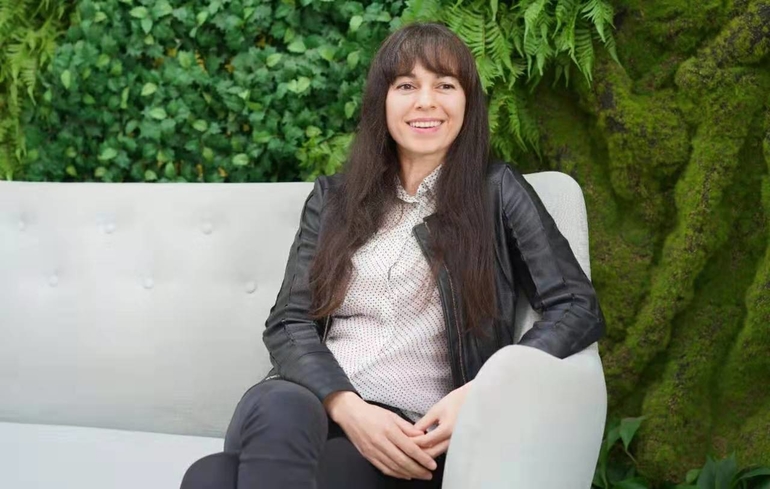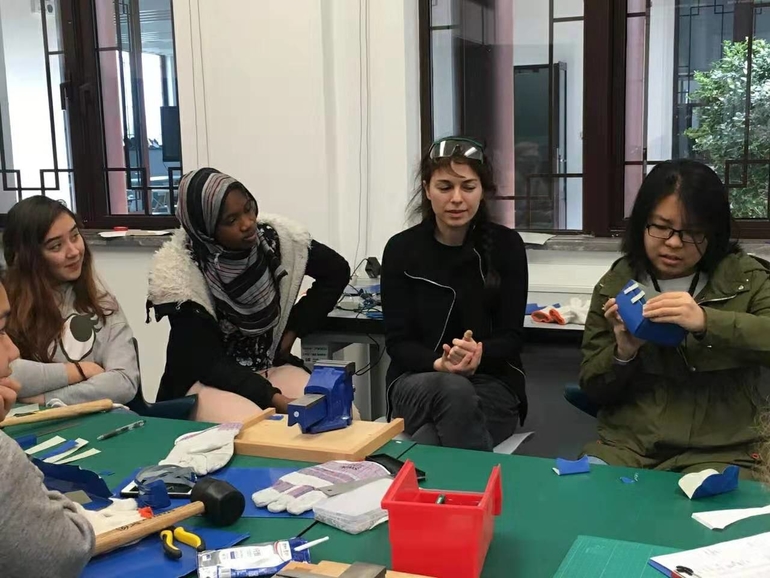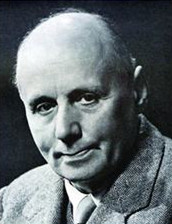Learning to Invent the Future
Issue date:2019-12-04Karen Kiene is a graduate of Li Po Chun UWC of Hong Kong. She holds a BFA in Industrial Design from Rhode Island School of Design and an MBA from Boston University.
Growing up on four continents made her curious about the interplay between individual experience and the bigger picture. Her interest in solving system problems led her to a career in industrial design, followed by experience in corporate marketing, tech product development and social entrepreneurship, including efforts to reduce single-use plastic.
Well experienced in design, business and sustainability, she was invited to be the 2019 Designer in Residence by UWC Changshu China to bring her expertise in "Design for a Circular Economy" to the students.

"They say this school destroys you, "a classmate confides," it makes you doubt everything you thought you knew. And then it rebuilds you in a different way."
"So, you mean, it’s like brainwashing?" Not in the classical sense.
Scary though it sounds, having my mind put through the grinder is among my favorite school memories, and it taught me the lessons I continue to draw on the most, whether for business or design or self-growth. I would recommend a similar experience to any aspiring "future leader" looking for a "world-class" education. Your school should twist your mind. It should flip your worldview. In a sense, it should give your brain a good scrubbing. Why? Because...
That's what good schools do
That's what good schools do
Let's backtrack a little and put this hyperbolic "brainwashing" dialogue in context. It is actually something I overheard at my alma mater, Rhode Island School of Design (RISD), an institution that does this well.
It was a sunny morning, about a year after my graduation from Li Po Chun UWC of Hong Kong, and I was huddled on the school lawn with a few other perplexed students. We were on break from a freshman foundation class that had us feeling adrift in uncertainty.
Having been "top art talent" at our high schools, we were now coming to grips with the realization that some of our profound ideas were actually quite pedestrian and that what we took for skill came off as contrivance. Through one critique after another, we had watched the professor dismantle with purposeful efficiency our artistic preconceptions of which we had been so certain.
In their place now extended a worrisome void which we struggled to fill. Looking behind us we could see where our old ideas fell short, but looking ahead we could not yet discern a viable alternative.
As it turns out, this was intentional. It meant RISD was doing its job. We would spend the next four years practicing being comfortable with the void that opens up whenever we shed existing preconceptions in search of new perspectives. In fact, we would learn to eagerly seek out this state of uncertainty, or rather, of possibility.
This sweet moment of creative destruction is where invention is born -- and it is not reserved only for artists and designers. It is the secret sauce behind what corporates like to tout as disruptive innovation. More importantly, it is essential for those of us who dream of transforming unsustainable social norms.
An experiment at UWC Changshu China
An experiment at UWC Changshu China

Fast forward twenty years:
As the Designer in Residence at UWC Changshu this spring, I am trying my hardest to coax a group of students through a similar journey of uncertainty and void-filling. In a spirit of continuous pedagogical innovation, the school has invited me to share my professional expertise at "creative problem solving for a circular economy."
Hence, the students and I are exploring the complexity behind garbage problems, and we are challenging beliefs that perpetuate a wasteful, linear system -- that is, the predominant economic system, wherein humans extract resources, make them into products, and discard them after use, with their value forever lost and the environment ruined a bit further.
A circular economy represents the antidote. It is modeled on living systems and seeks to keep resources circulating within a closed loop of perpetual reuse, without environmental degradation or loss of value.
Organizations everywhere are scrambling to figure out how to put this ideal into practice, how to orchestrate the controlled destruction of an old paradigm in favor of a new one -- a many-layered challenge that is proving quite vexing even within the microcosm of our school campus.
System maps, affinity diagrams and crude prototypes litter our studio, as the students try to extract insights from their stakeholder research. After dissecting a waste problem in numerous ways and repeatedly spinning their wheels, these young designers may find that the most limiting factor in achieving creative breakthroughs is their own attachment to conventional assumptions, which stymies their imagination.
Part of a broader mission
Part of a broader mission
The topic of circular economy is very much "en vogue," yet the school's affinity for it is as old as UWC's founding principles, which remain timeless in their relevance, and which prominently feature sustainability, human insight, and collaboration.
In that sense, UWC and RISD are of one spirit. They are built on the realization that we cannot invent the future by adhering to today's mindset.
So how does UWC seed a creative mindset? By seeding cognitive dissonance. I guarantee that you will be pulled out of your comfort zone and have your preconceptions challenged.
Through constant interaction with the most diverse group of people you will ever befriend, you will be exposed to endless different points-of-view on everything from cheese to colonialism. You will often find yourself in two minds, uncertain what to believe in, only to discover that apparent contradictions can co-exist once you adjust your assumptions. The paradox inside the mind is resolved in the act of creative reframing.
Preparation for the "real" world
Preparation for the "real" world
When we feel stuck, it tends to be because we have exhausted all obvious possibilities. Re-framing the question "What if there is a different way of looking at things?" For example, What if the Earth is not the center of the universe? What if humans are not the apex of evolution? History shows that when we challenge our frame of reference, it can open up whole new worlds of intellectual possibility.
This art of creative re-framing lies at the heart of breakthroughs large and small. It contributes not only to scientific discovery, but also to environmental solutions, conflict mediation, and more.
In some dry areas of Burkina Faso, for example, communities found themselves desperately digging deeper and deeper wells to get at an ever dwindling water supply until a new way of thinking emerged: What if we shift our energy from getting water out of the ground to getting water into the ground? The low water table was in fact a man-made problem resulting from over-grazing which had led to hard soil that prevented rain from entering the ground. The shift in focus inspired sustainable land management initiatives that not only restored the groundwater reserves, but also improved grazing areas and even created novel economic opportunities particularly for women.
On a more mundane level, reframing is ubiquitous in marketing. For example, Procter & Gamble developed a fragrant laundry detergent to respond to mothers’ desire for some sensual "me time." Surprisingly, the product almost flopped. Was the product bad? Was the research insight about "me time" wrong? Not at all, but it turned out that mothers felt guilty about self-indulgence. Through product messaging that reframed self-indulgence in the context of family care, Procter & Gamble managed to resolve the conflict inside the consumers’ minds, and the product ended up selling quite well.
No matter the challenge, there is an implication of optimism and resilience in creative reframing -- the ability to get unstuck, see a path forward, turn lemons into lemonade. Change is constant, conflict and crises are inevitable, and options will sometimes appear to run out. That is why a proper education needs to go well beyond mastering trending tools and topics. It should develop an inventive mind eager to engage with, and even co-create, what is to come.
It takes courage to be creative
It takes courage to be creative
- End -











